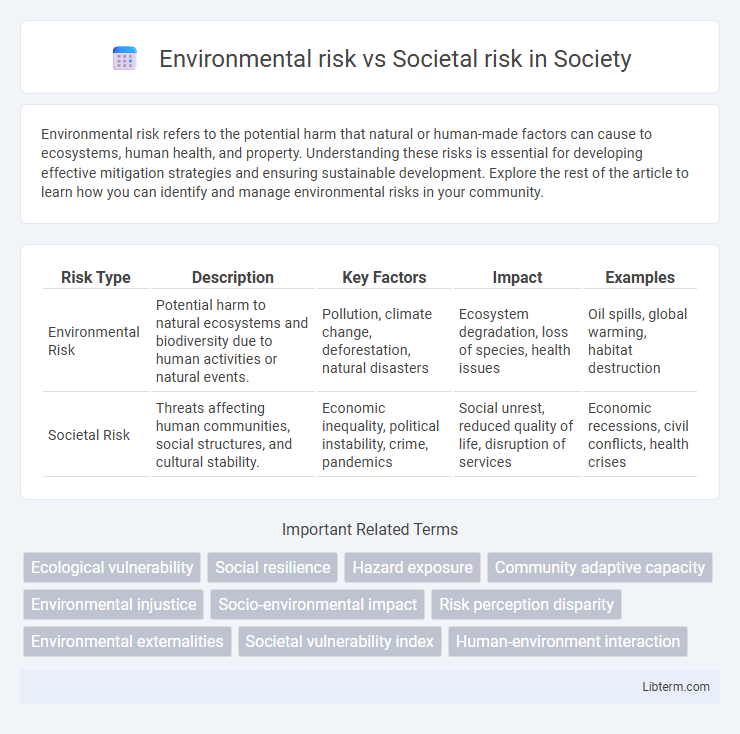Environmental risk refers to the potential harm that natural or human-made factors can cause to ecosystems, human health, and property. Understanding these risks is essential for developing effective mitigation strategies and ensuring sustainable development. Explore the rest of the article to learn how you can identify and manage environmental risks in your community.
Table of Comparison
| Risk Type | Description | Key Factors | Impact | Examples |
|---|---|---|---|---|
| Environmental Risk | Potential harm to natural ecosystems and biodiversity due to human activities or natural events. | Pollution, climate change, deforestation, natural disasters | Ecosystem degradation, loss of species, health issues | Oil spills, global warming, habitat destruction |
| Societal Risk | Threats affecting human communities, social structures, and cultural stability. | Economic inequality, political instability, crime, pandemics | Social unrest, reduced quality of life, disruption of services | Economic recessions, civil conflicts, health crises |
Introduction to Environmental and Societal Risks
Environmental risks encompass potential harm to ecosystems, biodiversity, and natural resources caused by phenomena such as pollution, climate change, and habitat destruction. Societal risks involve threats to human health, safety, social stability, and economic well-being arising from factors like pandemics, industrial accidents, and social unrest. Understanding both environmental and societal risks is crucial for developing integrated risk management strategies that safeguard both ecological integrity and community resilience.
Defining Environmental Risk
Environmental risk refers to the potential harm or adverse effects that natural or human-induced environmental factors pose to ecosystems, human health, and biodiversity. It encompasses hazards such as pollution, climate change, natural disasters, and toxic exposures that can disrupt ecological balance and threaten community well-being. Understanding environmental risk involves assessing vulnerability, exposure, and the likelihood of environmental damage to inform prevention and mitigation strategies.
Understanding Societal Risk
Societal risk refers to the potential adverse effects on a community or population due to hazardous events, encompassing both the likelihood of occurrence and the magnitude of consequences, such as fatalities, injuries, and economic losses. Understanding societal risk involves assessing system vulnerabilities, exposure levels, and social dynamics that influence how hazards impact collective well-being. Unlike environmental risk, which focuses on ecological damage, societal risk emphasizes human health, safety, and social disruption outcomes.
Key Differences Between Environmental and Societal Risks
Environmental risk primarily concerns the potential harm to ecosystems, natural resources, and biodiversity due to factors such as pollution, climate change, and habitat destruction. Societal risk involves the impact on human communities, including public health, safety, economic stability, and social cohesion, often driven by disasters, pandemics, or technological failures. The key difference lies in environmental risk focusing on ecological systems while societal risk emphasizes human and social consequences.
Intersections: How Environmental Risks Impact Society
Environmental risks such as climate change, pollution, and resource depletion directly affect societal well-being by increasing health problems, economic instability, and displacement of populations. The intersection of environmental and societal risks is evident in rising incidents of natural disasters that disrupt communities, strain infrastructure, and hinder access to essential services. Mitigating these interconnected risks requires integrated policies addressing both ecological sustainability and social resilience.
Examples of Environmental Risks
Environmental risks include natural disasters such as hurricanes, wildfires, and earthquakes that can cause widespread damage to ecosystems and human communities. Chemical spills, deforestation, and pollution also pose significant risks by contaminating air, water, and soil, threatening biodiversity and public health. These risks often lead to long-term ecological imbalance and disrupt the sustainability of natural resources critical for human livelihoods.
Examples of Societal Risks
Societal risks encompass threats that impact communities, such as pandemics, social unrest, economic collapses, and technological failures disrupting critical infrastructure. For instance, disease outbreaks like COVID-19 demonstrate how health crises can strain healthcare systems and economies globally. Similarly, large-scale cyberattacks or financial crashes illustrate societal risks that challenge public safety and social stability.
Risk Assessment Strategies
Environmental risk assessment strategies prioritize analyzing ecological impacts, hazard identification, and exposure evaluation to prevent damage to ecosystems and biodiversity. Societal risk assessments focus on evaluating potential consequences for human health, safety, and socioeconomic stability, incorporating public perception and vulnerability analysis. Both strategies utilize quantitative modeling, scenario analysis, and stakeholder engagement to develop effective risk mitigation and decision-making frameworks.
Policy Approaches to Mitigating Both Risks
Policy approaches to mitigating environmental and societal risks involve integrated frameworks that address climate change, public health, and social equity simultaneously. Regulatory measures such as emissions reduction standards, disaster preparedness plans, and inclusive urban development policies enhance resilience against ecological degradation and social vulnerabilities. Investment in green infrastructure, community engagement programs, and cross-sector collaboration ensures sustainable risk management and promotes long-term societal well-being.
Future Outlook: Managing Environmental and Societal Risks
Future outlooks for managing environmental and societal risks emphasize the integration of advanced data analytics and sustainable development practices to mitigate climate change impacts and social inequalities. Emphasizing proactive policies, such as green infrastructure investments and community-based resilience programs, enhances adaptive capacity across ecosystems and human populations. Effective risk management increasingly relies on cross-sector collaboration and innovation to address complex interdependencies between environmental degradation and societal vulnerabilities.
Environmental risk Infographic

 libterm.com
libterm.com